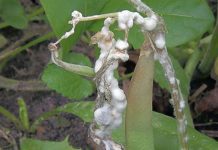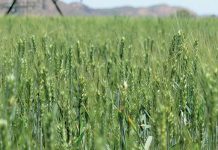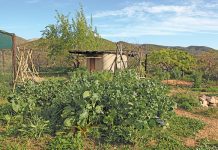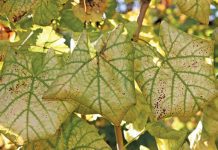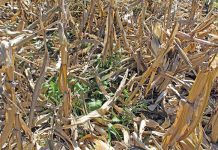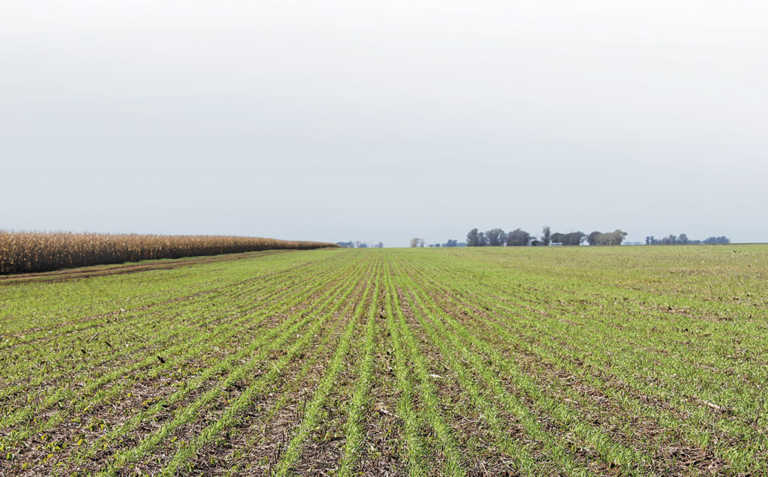
Photo: FW Archive
I was recently on the steps of City Hall in Los Angeles, addressing a protest about the lack of action on climate change.
Afterwards, I was surrounded by people wanting to know the meaning of the word ‘humus’. I was surprised that these people, giving up part of their weekend to protest about a lack of action on climate change, had not understood the single most important component of my speech.
What exactly is humus?
It is the sweet-smelling, chocolate-brown substance that is the essence of soil fertility. It is the stabilising soil glue that determines whether or not dust storms and floods will strip our thin veil of precious topsoil.
Many people don’t understand that soils hold together based on their organic matter component. Humus is also the storage system for three crucial substances that have an impact on soil, plant, animal, human and planetary health: carbon (C) minerals and water.
Agriculture contributes 25% of global carbon dioxide (CO2) emissions, 60% of methane (CH4) emissions and 80% of nitrous oxide (N2O) emissions.
According to soil physics expert, Professor Rattan Lal of Ohio State University in the US, agriculture has contributed 476 gigatons (476 000 billion tons) of CO2 to the atmosphere via the loss of humus from soils. Historically, the earth’s soils averaged 5% humus content.
This average now sits at 1,5%.In December last year, an article in Scientific American revealed that, at the current rate of top soil loss as a result of reduced humus content, we have 60 years left of this precious resource.
Of course, we would have hit the wall way before then. In 30 years, there will be 12 billion people on the planet. At that time, it’s possible that only half of the planet’s topsoil will remain.
If nothing changes between now and then, we’re going to struggle – topsoil is what we use to produce our food. We can’t survive without it.
A great deal of the carbon once stored in the soil is now stored in the atmosphere and this is the largest contributor to climate change. We desperately need to return this carbon back to the soil as humus.
READ Clay soils cultivation: a beginner’s guide
Lal says that we can counter 30% of mankind’s CO2 emissions by embarking upon programmes that build humus rather than lose it. His research is based on humus increases in just the top 15cm of the world’s agricultural soils.
This is a very conservative estimate because plant roots move much deeper down than 15cm, and it is the glucose exudates from these roots that serve as the building block for humus.
A 1,6% increase in organic matter in our soil across the globe would drop the current atmospheric CO2 level of 400 parts per million to below 300 parts per million, which effectively reverses climate change.
A huge percentage of farmers globally already suffer the ravages of climate change. Some are voluntarily leaving agriculture, going bankrupt or being forced off their farms.
The most important attributes for farming success in this brave new world are adaptability and flexibility.
This is not a time for apathy, it is a call to action – and it’s all about the soil. All countries should have a Soil Restoration Act. This year is the International Year of Soils and we need to wake up.
Twelve ways to combat humus loss in soil
There are 12 productive strategies that can help address the greatest challenge that mankind has faced to date – climate change.
1. Recognise your spending power: Corporations contributing to planetary destruction can only continue doing so if people continue to buy shares in them or buy their products. The same is true for food producers. Consumers can vote with their wallets and buy their food from growers practising regenerative farming methods.
Over the past two decades, Nutri-Tech Solutions has carried out thousands of tests on soil from over 50 countries. Our findings, as well as those of our colleagues, suggest that industrial, extractive agriculture typically removes humus from the soil each year, while sustainable strategies are usually building organic matter each year. When consumers look after the people who are trying to save the world, others follow, and meaningful change is initiated.
2. Paying carbon credits: Primary food producers should be paid for the carbon they sequester from the atmosphere by increasing the humus in their soils. Many people do not understand this process – the number of carbon molecules on the planet remains unchanged. The agricultural sector needs to lobby for carbon credits and governments need to create incentives. Many farmers are struggling as a result of climate change. Payment of carbon credits for humus-building will help farmers secure a valuable second income.
3. Composting: Composting should be an integral part of everyone’s lifestyle – from individual contributions of kitchen waste, leaf litter and lawn clippings, to councils and farmers utilising everything that is compostable. The compost can be added to the soils of home vegetable gardens and croplands, where it will provide a stabilised carbon source for the soil and reintroduce huge numbers of soil microbes that can digest crop residues more effectively.
The humus-building process is thus restored and these soils become healthier, more productive and more profitable. They also retain water more efficiently. An increase of just 1% organic matter means that soil can retain 170 000l water/ha that it could not previously store. There is no evaporation beneath the surface and there is no carbon footprint in delivering that water to the crop.
4. Soil inoculation: Soils should be inoculated with humus-building micro-organisms, the most important being mycorrhizal fungi. This creature is arguably the most important organism on earth at present. Mycorrhizal fungi produce a sticky, C-based substance called glomalin, the triggering mechanism for humus-building. In fact, current thinking is that this one creature is responsible for 30% of the humus in our soils. Extractive agriculture has decimated mycorrhizal fungi – to the extent that there are less than 20% of them remaining.
They can be reintroduced for less than R200/ha and there should be government subsidies to incentivise their repopulation. Most soils are also missing effective populations of other vitally important cellulose-digesting micro-organisms that help to break down fibrous plant materials such as crop residues. These organisms produce stable humus that can last for 35 years in the soil and be multiplied and reintroduced with a simple, inexpensive process called ‘microbe brewing’.
5. Legislation: The introduction of legislation to protect these vital organisms is necessary. We need to ask why the populations of mycorrhizal fungi and cellulose-digesting fungi have been so drastically reduced in our food-producing soils, and we need to do something about it now.
Why? Mycorrhizal fungi live in a symbiotic relationship with plant roots. They burrow into the root like a parasite, but they are anything but, as they give much more than they take. Their filaments (hyphae) fan out into the soil to form an enormous root extension – in fact, these filaments increase the root surface area tenfold.
They also exude acids that break the bonds between calcium (Ca) and phosphorous (P), increasing the availability of both minerals to the crop. These are the two single most important minerals that fuel the most important process on earth – photosynthesis. In addition, mycorrhizal fungi produce biochemicals that stimulate plant immunity and discourage destructive root-knot nematodes. Like all organisms in the soil, if we look after them, they will look after us.
6. Grazing livestock: More soils are grazed than cultivated, and they offer a great opportunity for addressing global warming. Changing grazing management is a major opportunity to build humus in our soils.
The most productive soils ever were those on the Great Plains of North America. Huge herds of bison grazed the Great Plains, causing tremendous impact on the vegetation and soils, including depositing vast amounts of mineral-rich dung and urine on the soils.
As the herds migrated they intensively grazed, but always left no less than 10cm of grass behind them.
This grass is the solar panel that energises photosynthesis and the associated deposit of carbon in the soil. If all that is left after grazing is 2cm, which occurs in much of the world, the roots, which are supported by that solar panel, prune themselves according to the reduced supply of energy.
The soil microbes are underfed and these soils can no longer build humus. The bison herds’ cycle of intensive but managed grazing promoted the growth of large root systems in the vegetation.
In turn, this dramatically enhanced the health and fertility of the soils, and made the area the most productive on the planet.
This type of livestock impact, and the positive soil and natural vegetation response, has been seen time and again. The Isted farms near Lady Grey in the Drakensberg are an example of this potential.
The world’s livestock farmers must start copying nature by implementing cell grazing or strip grazing to achieve similar results. Governments must support this practice wherever possible.
7. Ban the burning of crop residues: Unless absolutely essential, there should be a legislated ban on the burning of crop residues. Not only does burning destroy food for beneficial cellulose-digesting fungi, but every 100kg of burned plant material produces 5kg of mineral-rich ash, which is lost to the atmosphere.
Instead, crop residues should be left to decompose to benefit soil life and other plants growing in the soil, and to produce humus. Inoculating soils with cellulose-digesting fungi will help speed up the decomposition of crop residues into the soil.This is a simple and inexpensive process.
8. Green manure and cover crops: Research at the Department of Agriculture in the US suggests that cocktail cover crops between primary crops can be a tremendously productive C-sequestering tool. These crops are vital for feeding the soil while building its humus content.
Researchers have found that planting a cocktail of at least five different cover crops – cereals, grasses, brassicas, legumes and chenopods – results in the plants releasing phenolic compounds into the soil that trigger humus-building.
9. Crassulacean acid metabolism (CAM) plants: CAM plants are a soil C-building phenomenon that have huge potential for sequestering atmospheric carbon back into the soil. They are absurdly easy to propagate and thrive in arid and low-humus soils. They are able to build carbon into soils at least twice as efficiently as any other type of plant.
CAM plants that can be grown in South Africa include the spekboom and the moringa tree.
These species can, in particular, be used to rehabilitate degraded soils while reducing greenhouse gases from the atmosphere. The moringa tree is also one of the most nutrient-dense plant species on earth, and people and livestock can benefit greatly from eating its leaves and seeds.
10: Production and utilisation of biochar: When incorporated into degraded soils, biochar (charcoal) becomes a homebase for beneficial soil microbes and acts as an effective retainer of soil moisture. It also appears to have a synergy with mycorrhizal fungi, encouraging these fungi to spread throughout the soil. As a result, biochar is a major contributor to humus creation in the soil and can therefore act as a mitigating factor against climate change.
11. Carbon source in fertilisers: Every living organism has a carbon to nitrogen ratio (C:N). Trees have a 500:1 C:N ratio, while soil nematodes, good and bad, have a ratio of 100:1. Humans have a 30:1 ratio, while soil bacteria have the highest ratio of 5:1. This means that their tiny bodies are actually 17% N.
They crave it, and when we apply fertiliser they embark on a feeding frenzy. They seek the carbon to balance out their tight ratio. If we apply N without carbon, the bacteria have no choice but to consume soil humus as their carbon. The solution to averting this loss of soil carbon is to include carbon in fertilisers. It can be molasses with liquid N, or compost with dry N sources. It might also include carbon-dense material called humates, which are extracted from coal and are indispensable humus-building tools.
12. Humic acid: Humic acid is the most powerful fungal stimulant known to man. This makes it exceptionally important as an aid to replenish the beneficial fungi in our soils that have been so badly affected by modern agriculture. Soluble humate granules can easily be combined with NPK fertilisers. Soluble fulvic acid powder can be dissolved and combined with all foliar inputs to chelate and magnify these inputs, while stimulating leaf and soil life.
Bottom line
Promoting humus-building in our world’s soils is the ultimate win/win scenario. Not only can we sequester sufficient carbon to reverse global warming, but this magic substance is also the ultimate soil fertility tool. It will increase sustainability and profitability in agriculture while improving the nutrient value of the food that sustains us.
Email Graeme Sait at graeme@nutri-tech. Visit www.nutri-tech.com.au
This presentation was given at a recent soil health seminar hosted by Zylem, which represents Nutri-Tech Solutions (NTS) (Australia) and Brookside Laboratories Incorporated (USA) in South Africa. Seminars were held in KwaZulu-Natal in April as well as in Paarl, Jeffrey’s Bay and Potchefstroom. For more information on NTS and Brookside Laboratories in South Africa, phone Zylem on 033 347 2893 or email: [email protected].


